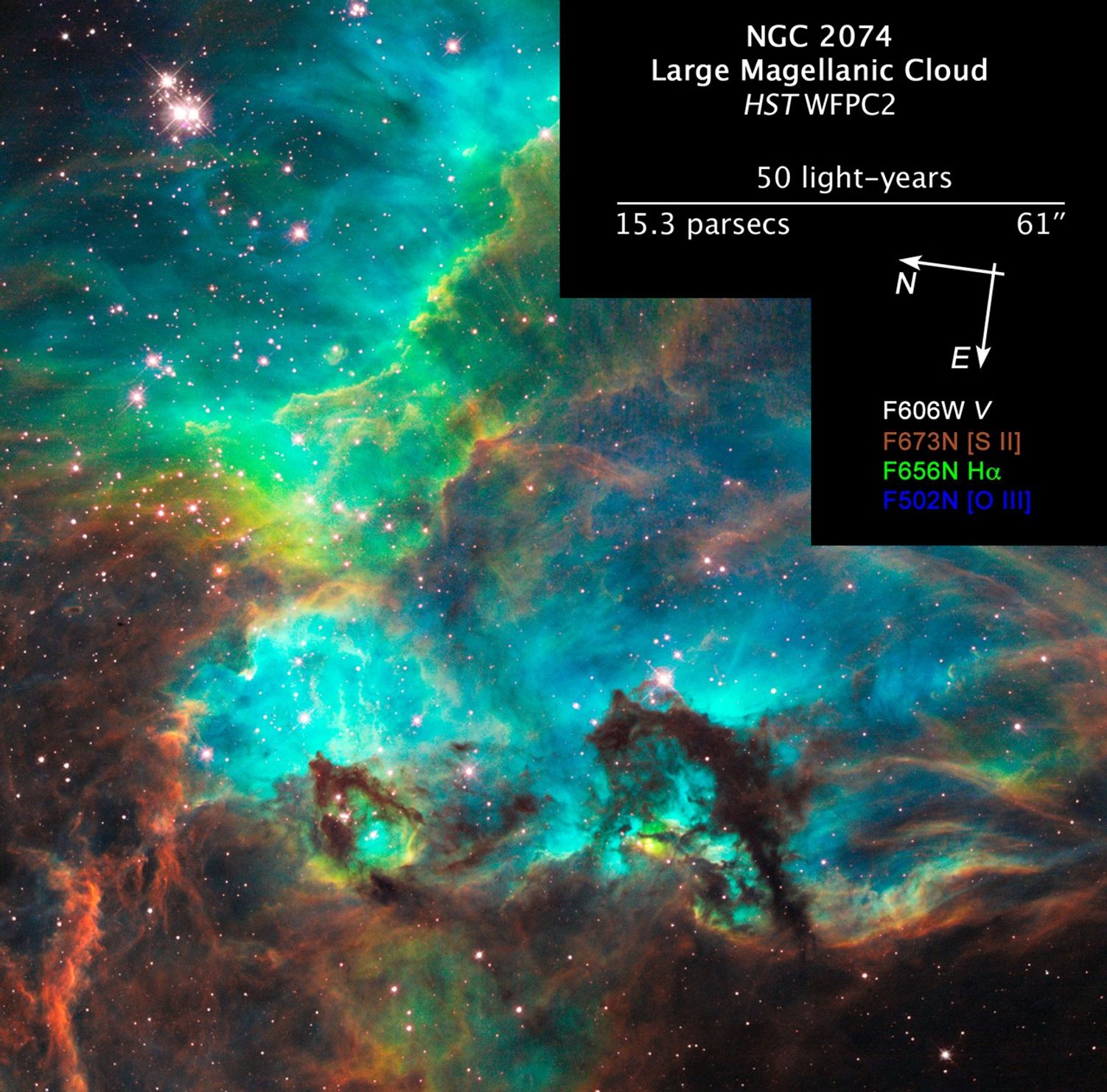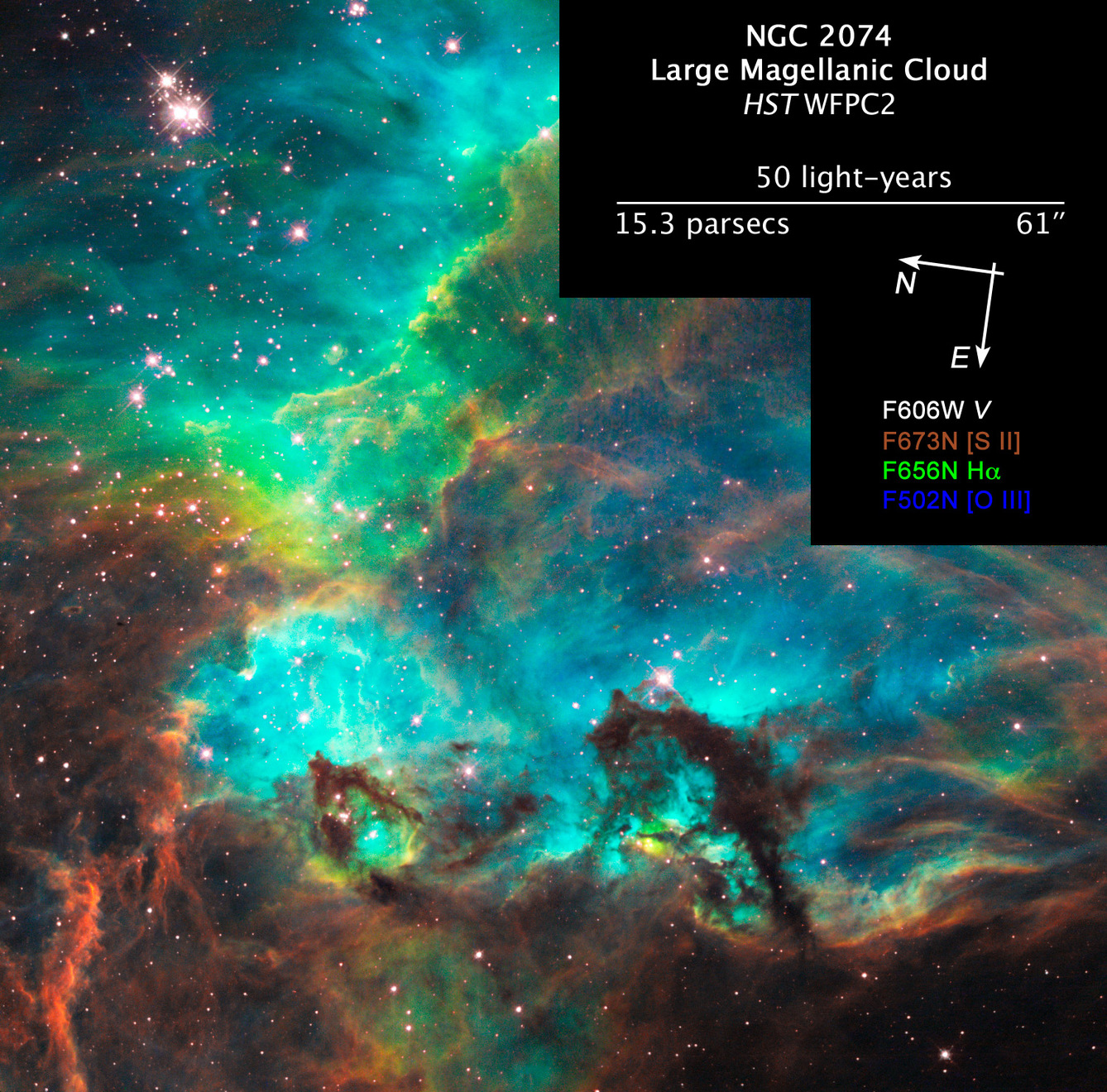1 min read
Compass File and Scale for NGC 2074

About the Object
- R.A. PositionR.A. PositionRight ascension – analogous to longitude – is one component of an object's position.05h 39m 2.44s
- Dec. PositionDec. PositionDeclination – analogous to latitude – is one component of an object's position.-69° 29' 38.01"
- ConstellationConstellationOne of 88 recognized regions of the celestial sphere in which the object appears.Dorado
- DistanceDistanceThe physical distance from Earth to the astronomical object. Distances within our solar system are usually measured in Astronomical Units (AU). Distances between stars are usually measured in light-years. Interstellar distances can also be measured in parsecs.170,000 light-years (52 kiloparsecs)
- DimensionsDimensionsThe physical size of the object or the apparent angle it subtends on the sky.This image is 150 arcseconds (120 light-years or 40 parsecs) wide.
About the Data
- Data DescriptionData DescriptionProposal: A description of the observations, their scientific justification, and the links to the data available in the science archive.
Science Team: The astronomers who planned the observations and analyzed the data. "PI" refers to the Principal Investigator.HST Proposal: 11807 M. Livio, Z. Levay, M. Mutchler, L. Frattare, and D. Taylor (STScI). Additional image processing by A. Bowers and B. Ferguson (STScI). - InstrumentInstrumentThe science instrument used to produce the data.HST>WFPC2
- Exposure DatesExposure DatesThe date(s) that the telescope made its observations and the total exposure time.August 10, 2008
- FiltersFiltersThe camera filters that were used in the science observations.F502N ([O III]), F656N (H-alpha), F673N ([S II]), and F606W (V)
- Object NameObject NameA name or catalog number that astronomers use to identify an astronomical object.NGC 2074
- Object DescriptionObject DescriptionThe type of astronomical object.Nebula in the Large Magellanic Cloud
- Release DateAugust 11, 2008
- Science ReleaseHubble Unveils Colorful and Turbulent Star-Birth Region on 100,000th Orbit Milestone
- Credit

The image is a composite of separate exposures made by the WFPC2 instrument on the Hubble Space Telescope. Three filters were used to sample narrow wavelength ranges matching the emission of specific chemical elements. One filter was used to sample a broad wavelength randge in the visible. The color results from assigning different hues (colors) to each monochromatic image. In this case, the assigned colors are: Blue: F502N ([O III]) Green: F656N (H-alpha) Maroon: F673N ([S II]) White: F606W (V)

Related Images & Videos

Star Cluster NGC 2074 in the Large Magellanic Cloud
In commemoration of NASA's Hubble Space Telescope completing its 100,000th orbit in its 18th year of exploration and discovery, scientists at the Space Telescope Science Institute in Baltimore, Md., have aimed Hubble to take a snapshot of a dazzling region of celestial birth and...

Hubble's Location at 100,000th Orbit Milestone (Artist's Illustration)
NASA's Hubble Space Telescope reached a milestone of 100,000 orbits at 7:42 a.m. EDT on Monday, August 11, 2008. At that time the telescope was flying above the midway point of the Pacific Ocean and directly over the equator, heading northward. Hubble completes an orbit around...

MCELS Annotated Image of a Portion of the Large Magellanic Cloud
Ground-based image of the region surrounding NGC 2074 in the Large Magellanic Cloud. These optical emission-line images were taken on the Curtis Schmidt telescope at Cerro Tololo Inter-American Observatory as part of the Magellanic Cloud Emission Line Survey. The composite image...
Share
Details
Claire Andreoli
NASA’s Goddard Space Flight Center
Greenbelt, Maryland
claire.andreoli@nasa.gov































